#analog guitar effects processor
Explore tagged Tumblr posts
Photo

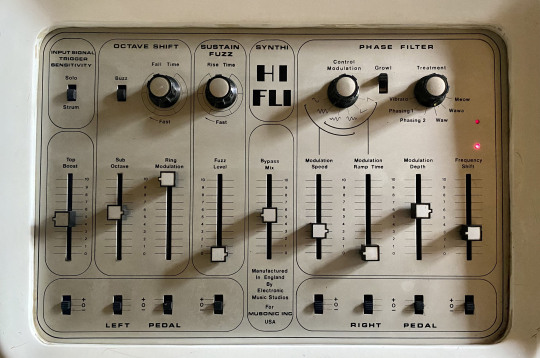
EMS Hi-Fli // guitar synth pedal - analog multi effect processor (UK, 1973)
832 notes
·
View notes
Text
Plugin Alliance & Brainworx – Plugins Bundle (Windows) Download

The Plugin Alliance & Brainworx Plugins Bundle is a powerhouse collection for music producers, mixing engineers, and audio enthusiasts. Designed for Windows 10 and 11 (64-bit), this bundle offers a comprehensive suite of plugins covering EQs, compressors, reverbs, delays, amplifiers, and much more. With lifetime activation, future updates, and instant download, it’s a must-have for professionals seeking world-class audio tools.
Download Here Plugin Alliance & Brainworx Plugins Bundle.
Key Highlights
A Comprehensive Collection of Plugins
From EQs to dynamic processors, modulation effects, and amp simulators, this bundle includes a wide range of tools for every audio need.
Features plugins like bx_console AMEK 9099, bx_masterdesk Pro, and bx_oberhausen, renowned for their precision and musicality.
Unmatched Audio Quality
Developed by Brainworx Audio, known for creating audio-leading plugins and multi-platform tools.
Each plugin is meticulously crafted to deliver studio-quality sound.
Cutting-Edge Technology
Powered by Plugin Alliance, offering state-of-the-art authorization and seamless integration with major DAWs.
Supports VST, VST3, and AAX formats for broad compatibility.
Perfect for Every Studio Setup
Ultra-low CPU usage ensures smooth performance even in complex sessions.
Tailored for both beginners and seasoned professionals.
Included Plugins
Equalizers
bx_2098 EQ: Classic analog EQ emulation.
bx_digital V3: Precision digital mastering EQ.
Dynamics
bx_opto: Smooth optical compressor.
bx_townhouse Buss Compressor: Iconic buss compression with character.
Amp Simulations
bx_megadual: High-gain amp simulation for heavy tones.
bx_rockrack V3: Versatile guitar and bass amp suite.
Modulation and Effects
bx_bluechorus2: Warm vintage chorus.
bx_rooMS: High-quality reverb.
Mastering Tools
bx_masterdesk Pro: All-in-one mastering solution.
bx_XL V2: Advanced multi-band loudness maximizer.
Specialized Plugins
bx_crispytuner: Intuitive pitch correction.
bx_solo: Quick stereo imaging adjustments.
System Requirements
Operating System: Windows 10, 11 (64-bit).
Plugin Formats: VST, VST3, AAX.
Why Choose This Bundle?
Trusted Developers: Brainworx Audio and Plugin Alliance are industry leaders.
Future-Proof: Includes lifetime activation and free updates.
All-in-One Solution: From mixing to mastering, this bundle has it all.
Delivery Details
Full Version.
Instant Download.
Lifetime Activation.
Explore the power of professional audio tools with the Plugin Alliance & Brainworx Plugins Bundle. Transform your mixes and masters with precision and ease.
Download Here Plugin Alliance & Brainworx Plugins Bundle.
0 notes
Text
What Are the Top Tools for a Home Studio Setup?
Creating a home studio is like building your personal creative haven. Whether you're an aspiring musician, podcaster, or content creator, a well-equipped home studio can be a game-changer. But with so many tools and gadgets out there, figuring out what you actually need can feel overwhelming. Don’t worry—I’ve got you covered. Let’s dive into the essential tools for a home studio setup and why each one is important.
Computer or Laptop: The Brain of Your Studio
At the heart of every home studio is a reliable computer or laptop. This is where all the magic happens—recording, editing, mixing, and mastering. Your computer’s processing power matters a lot because audio production software can be demanding. While you don’t need a crazy expensive machine, aim for one with decent RAM (at least 8GB) and a fast processor.
Also, make sure it has enough storage for all your projects. Audio files can quickly pile up, so having external storage or a cloud backup plan isn’t a bad idea either.

Digital Audio Workstation (DAW): The Creative Hub
A Digital Audio Workstation, or DAW, is the software where you record, edit, and mix your tracks. Think of it as your virtual studio. The best part? You can choose a DAW that fits your needs and skill level, whether you're a beginner or a seasoned pro.
Many DAWs come with built-in virtual instruments, effects, and plugins, so you don’t have to buy everything at once. Take your time to explore tutorials and experiment with features to get the hang of it.
Audio Interface: Connecting Your Gear to Your Computer
An audio interface is a must-have for capturing high-quality sound. This device acts as the bridge between your microphone, instruments, and computer. It ensures that the analog sound you’re creating (like your voice or guitar) is converted into digital signals your computer can process.
When choosing an audio interface, pay attention to the number of inputs and outputs. If you're planning to record multiple instruments or vocals simultaneously, you’ll need an interface with enough ports to handle it.
Microphones: Capturing Crisp Audio
The microphone you choose depends on what you’re planning to record. Here are the two most common types:
Condenser Microphones: Ideal for vocals and capturing fine details in sound. These are great for singers, voiceovers, or podcasters.
Dynamic Microphones: Best for loud sources like drums or amplified instruments. They’re more durable and better at isolating unwanted noise.
Don’t forget to invest in a pop filter or windscreen to reduce plosive sounds (like those harsh “P” and “B” sounds) when recording vocals.

Studio Monitors: Hearing the Real Sound
Studio monitors are speakers designed specifically for accurate sound reproduction. Unlike regular speakers that enhance bass or treble, studio monitors give you a flat, uncolored sound. This helps you hear your recordings as they truly are, making it easier to fine-tune your mixes.
If monitors are out of your budget initially, high-quality studio headphones can be a good alternative. However, eventually investing in monitors will give you a more accurate sense of how your tracks will sound to listeners.
MIDI Controller: Enhancing Creativity
A MIDI controller is a game-changer if you work with virtual instruments or produce electronic music. It’s essentially a keyboard that lets you play, tweak, and program sounds in your DAW. You can use it to create drum beats, play melodies, or even orchestrate an entire symphony—right from your home studio.
MIDI controllers come in various sizes, so pick one that fits your workspace and musical goals.
Acoustic Treatment: Getting the Best Sound
Here’s the thing: even the best audio equipment can fall short if your room isn’t acoustically treated. Rooms with hard surfaces tend to cause echoes and distort sound, which can mess up your recordings and mixes.
To fix this, add acoustic panels, bass traps, or foam pads to your walls. These help absorb unwanted sound reflections and create a balanced listening environment. Don’t worry—you don’t have to cover your entire room. Focus on key areas like the walls behind your speakers and the corners of the room.
Cables and Stands: The Unsung Heroes
While they may not be the most exciting part of your setup, good-quality cables and sturdy stands are crucial. Faulty or cheap cables can introduce noise into your recordings, which is the last thing you want after hours of work.
For microphones, invest in an adjustable stand that allows you to position the mic perfectly. If you’re recording with instruments, a sturdy instrument stand will keep your gear safe and accessible.
External Hard Drive: Backup Is Everything
Imagine spending hours perfecting a track, only for your computer to crash and lose everything. That’s a nightmare no one wants. Having an external hard drive ensures your projects are backed up and safe.
Look for one with plenty of storage space and a fast transfer rate. Alternatively, you can use cloud storage services, but an external drive is always a good backup plan.
Patience and Practice: The Real Secret Weapon
Okay, this might sound cheesy, but patience and practice are just as important as any gear. Learning how to use your equipment, understanding the software, and refining your skills takes time. Don’t get discouraged if your first few recordings don’t sound amazing—it’s all part of the process.
A Quick Note About Buying Equipment
When it comes to purchasing your home studio tools, quality matters. Professional audio shops like VIP PRO AUDIO are a great place to start, as they often offer expert advice and ensure you're getting reliable gear. Investing in the right equipment from the beginning will save you money and frustration in the long run.
Conclusion: Your Studio, Your Rules
Building a home studio is an exciting journey. It’s not just about the gear—it’s about creating a space where your creativity can thrive. Start with the essentials like a computer, DAW, and microphone, and gradually expand your setup as your skills and needs grow.
Remember, you don’t need to break the bank to get started. Focus on quality over quantity and make smart investments. Before you know it, you’ll have a home studio that’s not only functional but also inspires you to keep creating. So, what are you waiting for? Start setting up your dream studio today!
0 notes
Text
Plugin Alliance & Brainworx – Bundle 2024 Download

Elevate your audio production to new heights with the Plugin Alliance & Brainworx Bundle 2024. This comprehensive collection of 39 top-tier plugins is your ticket to professional-grade sound, covering every aspect of mixing, mastering, and creative sound design. Whether you’re an experienced audio engineer or an aspiring music producer, this bundle is packed with powerful tools to bring your creative visions to life.
What’s Inside the Plugin Alliance & Brainworx Bundle?
Mastering Excellence: Achieve pristine clarity with legendary tools like bx_digital V3 M/S EQ, bx_masterdesk, and bx_XL V2 M/S Limiter. These industry-standard plugins set the benchmark for audio perfection.
World-Class Console Emulations: Recreate the sound of iconic analog consoles with the bx_console series, featuring TMT (Tolerance Modeling Technology) for unparalleled realism. From SSL to Focusrite, experience the warmth and depth of analog gear in your digital workflow.
Dynamic EQs and Compression: Fine-tune your sound with cutting-edge EQs, master buss compressors, and dynamic processors designed to handle even the most demanding projects.
Incredible Synths and FX: Explore the TMT synthesizer inspired by the Oberheim SEM, and enhance your tracks with a range of guitar/bass amps, distortion effects, and modulation tools.
Reverb, Delay, and Mix Utilities: Add depth and dimension with bx_rooMS and bx_delay 2500, or fine-tune your mix with tools like bx_stereomaker and bx_control V2.
Why Choose This Bundle?
Brainworx is known for its precision engineering and innovation, making it a favorite among top studios and engineers worldwide. These plugins aren’t just tools; they’re the backbone of professional productions, providing unmatched quality and versatility. With AAX DSP support and compatibility across all native formats, the bundle seamlessly integrates into any setup.
Exclusive Offer
For just $12.99/month, you gain unlimited access to every current and future Brainworx plugin—guaranteed! No additional costs, no removed features, just pure audio power.
Don’t settle for anything less than the best. Download the Plugin Alliance & Brainworx Bundle 2024 today and take your music production to the next level.
👉 Download Now
0 notes
Text
A simple DIY guitar tremolo pedal
Have you ever thought of making your guitar sound differently or just livening things up a bit? In addition to reverb and chorus, a subtle tremolo can help. Today, I will build a very simple tremolo pedal using three transistors.

Of all the time-based effects, electronic tremolo is the easiest to get.
The important thing is that one does not need to alter amplifier bandwidth for tremolo, like in wah pedals and phasers, by electronically reconfiguring frequency-dependent circuits containing active and reactive resistances—resistors, coils, and capacitors.
There is no need to implement, much less modulate, the signal time delay. This is done in delays, reverbs, flangers, and choruses using mechanical, analog (bucket brigade devices, BBD), and digital delay lines.
Moreover, there is no need to process the frequency of the input signal. Raising the frequency by an octave is relatively simple; it takes a full-wave rectifier, similar to those used in power supply units.

A full-wave rectifier folds the wave. It turns the lower half-wave up, and now there is a whole period of the output signal for each half-cycle of the original signal.
We have doubled the fundamental frequency and added some harmonics. After all, the output signal is no longer sine. The upper half-wave is smooth, and the lower half-wave is pointy.
The first octave did not use a bridge rectifier with four diodes but a half-bridge rectifier with two diodes and a transformer with the winding having a midpoint.
Such a transformer was easy to find. For example, a phase-inverter matching transformer from a pocket transistor radio could do. We've put together a receiver of this kind in a post about the Regency TR-1.

It is unnecessary to use a transformer if you build a full-wave rectifier using operational amplifiers.

And finally, when making a phase inverter for a full-wave rectifier, you can do it without operational amplifiers. One transistor is enough. After all, the output signal at its emitter has the same polarity as the input signal at the base, and at the collector, it has inverted polarity.

Suppose the signal frequency needs to be decreased by half, not increased. In that case, that is, by one octave, then synchronous D-flip-flops, which we've discussed in previous articles, will be helpful.

A circuit divides the oscillator frequency on a 555 timer by 2, 4, 8, and 16. That is, by two to the first, second, third, and fourth powers. And if we speak musical terminology, we lower the tone by one, two, three, and four octaves.
However, electric guitar pickups do not produce digital pulses or even a sine wave but an analog signal of a complex shape with many harmonics. So, to divide the frequency with flip-flops, the guitar signal must be preprocessed by converting it into rectangular pulses.
One possible circuitry answer to this problem is in the diagram of this old Japanese pedal. Here, the signal on its way to the latches passes through a compressor and a Schmitt trigger.

The compressor is needed to process both loud and quiet notes effectively. Interestingly, the CMOS NAND gate circled in green on the diagram, is used as an analog signal amplifier.
This is doable. The ratio of the resistor value between the output and the inverting input of the CMOS inverter to the impedance in series with the input determines the gain, just like in an operational amplifier.
An excellent example of a pedal that uses CMOS inverters rather than transistors, op-amps, or tubes to amplify the guitar signal is the Tube Sound Fuzz circuit, designed by Craig Anderton and published in his 1975 book "Electronic Projects for Musicians."

Frequency dividers on flip-flops work well with a single note. And for a chord or pitch shifting at an interval of a non-integer octave number, a digital signal processor is almost always required.
Perhaps the only exception is the perfect fifth. The original frequency must be divided by three and multiplied by two to obtain it. Frequency division into three is possible using a single CD4013 chip containing two synchronous D-flip-flops with asynchronous setup and reset.

At each of the points of the circuit, marked with numbers 2, 3, and 4, there is a frequency from point 1, divided by 3, in the form of a PWM signal with a duty cycle of 2/3 or 1/3. For music, this sounds even better than a duty cycle of 1/2.
The phases of the signals at these points are shifted between each other, which can also be used for interesting sound effects. But there is one problem.
Modern music uses not natural but evenly tempered tuning. Therefore, our electronic fifth, played by flip-flops, will be slightly out of tune relative to the fifth on the guitar frets.
The frequency of this equal-tempered fifth is not equal to two-thirds the frequency of the original note but to the frequency of the original note divided by the 12th root of 128. This system allows one to freely transpose melodies and chord progressions from one key to another. That is why it became universally recognized.
And to get a tremolo, you don’t need all these tricks. Two functional blocks are enough: LFO and VCA, a low-frequency oscillator, and a voltage controller amplifier.
Each of them can be implemented literally on one transistor. This is precisely what the developers of the Univox/Unicord U65RN combo amplifier, produced since 1971, did.

Frequency dividers on flip-flops work well with a single note. And for a chord or pitch shifting at an interval of a non-integer octave number, a digital signal processor is almost always required.
Perhaps the only exception is the perfect fifth. The original frequency must be divided by three and multiplied by two to obtain it. Frequency division into three is possible using a single CD4013 chip containing two synchronous D-flip-flops with asynchronous setup and reset.

At each of the points of the circuit, marked with numbers 2, 3, and 4, there is a frequency from point 1, divided by 3, in the form of a PWM signal with a duty cycle of 2/3 or 1/3. For music, this sounds even better than a duty cycle of 1/2.
The phases of the signals at these points are shifted between each other, which can also be used for interesting sound effects. But there is one problem.
Modern music uses not natural but evenly tempered tuning. Therefore, our electronic fifth, played by flip-flops, will be slightly out of tune relative to the fifth on the guitar frets.
The frequency of this equal-tempered fifth is not equal to two-thirds the frequency of the original note but to the frequency of the original note divided by the 12th root of 128. This system allows one to freely transpose melodies and chord progressions from one key to another. That is why it became universally recognized.
And to get a tremolo, you don’t need all these tricks. Two functional blocks are enough: LFO and VCA, a low-frequency oscillator, and a voltage controller amplifier.
Each of them can be implemented literally on one transistor. This is precisely what the developers of the Univox/Unicord U65RN combo amplifier, produced since 1971, did.
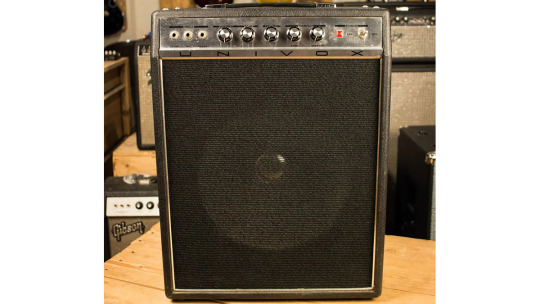
It had 15 watts of power, a 12-inch loudspeaker, and a spring reverb. It was assembled according to a relatively simple circuit by today's standards. However, at that time, it was considered quite complex.

Our attention should be drawn to the lower left corner, which shows the tremolo diagram. The leftmost transistor is used in the phase-shifting RC LFO. This generator produces harmonic sine waves, the frequency of which is controlled by the SPEED potentiometer.
Oscillations from the LFO output go to the modulation intensity control INT and to the second transistor's base. This transistor simply bypasses all input signals from the microphone, guitar, and organ. This is how the VCA is made.
And the tremolo pedal jack simply shorts the LFO signal to the ground, and the VCA transistor is completely turned off. This allows one to turn the tremolo on and off using a pedal with just a latching SPST button inside.
The diagram published by Anthony Leo in the November 1968 issue of Electronic Australia Magazine, 3 years before the Univox/Unicord U65RN, differs slightly from the tremolo found in this combo amp.
Since then, the circuit has been called the Electronic Australia tremolo or EA tremolo for short. It's a beloved one among pedal enthusiasts.

Here, the VCA comprises a common-emitter bipolar transistor Q1 and a JFET Q2 that bypasses most of Q1's AC bias resistance, thereby modulating the stage's gain.
I've assembled this DIY pedal kit from Landtone using just this scheme. In the video below, you can hear the resulting sound.
Due to such an exciting circuit design, the effect turned out to be very beautiful. This is the best tremolo I have ever encountered.
As we can see and hear with our own eyes and ears, excellent results can be achieved using simple means if you approach the project thoughtfully and with love.
0 notes
Text
Essential Components for a Beginners Home Studio Setup
Starting your own home studio can be an exciting journey for any musician or producer. Whether you're recording vocals, playing instruments, or producing beats, a well-equipped home studio is key to capturing great sound. Setting up a studio doesn’t need to be expensive or overly complex—getting the basics right can take you a long way. Here are the essential components you need to kickstart your home studio setup as a beginner.
1. **Computer or Laptop**
The heart of your home studio is your computer. Whether you prefer using a desktop or a laptop, you’ll need a machine that can handle the demands of music production software. Most modern computers will work fine, but aim for something with a fast processor (Intel i5 or higher) and at least 8GB of RAM to ensure smooth performance.
- **Tip**: If you’re serious about producing music, invest in more RAM (16GB or higher) and a solid-state drive (SSD) for faster file processing and loading times.
2. **Digital Audio Workstation (DAW)**
A DAW is the software that allows you to record, edit, and mix your music. Some popular options include:
- **GarageBand** (for Mac users) – beginner-friendly and free.
- **Ableton Live** – great for both live performances and studio production.
- **FL Studio** – excellent for electronic music and beat making.
- **Logic Pro X** – more advanced but packed with professional features.
- **Pro Tools** – the industry standard for professional music production.
Choose a DAW that fits your style and offers the features you need.
3. **Audio Interface**
An audio interface allows you to connect your instruments, microphones, and speakers to your computer. It converts analog signals (like guitar or vocals) into digital signals that your computer can process.
- **Tip**: Look for an audio interface with at least two inputs (so you can record vocals and an instrument simultaneously) and one or two headphone outputs. Popular beginner interfaces include the **Focusrite Scarlett 2i2** or the **PreSonus AudioBox**.
4. **Studio Monitors**
Studio monitors are speakers designed specifically for music production, offering a flat, accurate frequency response. Unlike consumer speakers, which often color the sound (boosting bass or treble), studio monitors provide an unaltered representation of your recordings.
- **Tip**: Look for affordable monitors like **Yamaha HS5** or **KRK Rokit 5**, which offer great sound quality for beginners.
5. **Studio Headphones**
While studio monitors are ideal for mixing, studio headphones are essential for detailed listening and late-night sessions. You'll want closed-back headphones for recording (to prevent sound bleed into the mic) and open-back headphones for mixing (for a more natural sound).
- **Tip**: The **Audio-Technica ATH-M50X** or the **Sony MDR-7506** are popular options known for their clarity and comfort.
6. **Microphone**
A good microphone is crucial for recording vocals and instruments. For beginners, a **condenser microphone** is a great all-round option because it’s sensitive and captures a broad frequency range, making it ideal for vocals and acoustic instruments.
- **Tip**: Consider the **Audio-Technica AT2020** or **Rode NT1-A** as budget-friendly but high-quality options.
7. **MIDI Controller**
If you plan on producing electronic music or adding virtual instruments to your tracks, a **MIDI controller** is a must. MIDI controllers allow you to play software instruments in your DAW using a keyboard or drum pads.
- **Tip**: The **Novation Launchkey Mini** or **Akai MPK Mini** are compact, beginner-friendly MIDI controllers with easy-to-use features.
8. **Pop Filter**
A pop filter is a simple yet effective tool that prevents harsh plosive sounds (like "p" and "b") from ruining your vocal recordings. It’s placed in front of the microphone to soften bursts of air from the vocalist.
- **Tip**: You don’t need to spend much on a pop filter. Basic models are affordable and get the job done well.
9. **Microphone Stand**
Having a stable microphone stand is essential for keeping your mic in place while recording. Adjustable stands are recommended to accommodate different recording situations, whether you’re standing, sitting, or playing an instrument.
- **Tip**: The **K&M Microphone Stand** is durable, adjustable, and perfect for home studio use.
10. **Cables**
Good quality **XLR cables** for your microphone and **TRS/TS cables** for your instruments are vital to ensure a clean, noise-free signal. Always have a few spare cables on hand in case one breaks or becomes faulty.
- **Tip**: Invest in durable cables from reputable brands like **Mogami** or **Planet Waves** to avoid signal interference.
11. **Acoustic Treatment**
Soundproofing your room is key to achieving high-quality recordings and mixes. Bare walls and reflective surfaces can cause unwanted echoes and muddy sound. Start with some basic **acoustic panels** or **bass traps** to absorb sound and prevent reflections.
- **Tip**: You can also make DIY acoustic panels for a budget-friendly option (check out our DIY guide for more information).
12. **External Hard Drive**
Recording and producing music takes up a lot of storage space. An external hard drive is essential for backing up your projects, sound libraries, and samples to prevent data loss.
- **Tip**: Choose a **SSD external drive** for faster file transfers. Brands like **Samsung** and **SanDisk** offer reliable options.
Conclusion
With these essential components, you'll have a strong foundation for building your home studio. Start with the basics, and as your skills and budget grow, you can expand your gear to suit your evolving needs. Remember, it’s not about having the most expensive equipment; it’s about making the most of what you have and creating great music from the comfort of your own space. Happy recording!
#HomeStudio#BeginnersGuide#MusicProduction#StudioSetup#HomeRecording#AudioEquipment#CreativeSpace#SoundDesign#MusicMaking#HomeStudioEssentials
0 notes
Text
How to Download Ableton Live Suite 12

Welcome to our detailed guide on how to download Ableton Live Suite 12. This professional music production software has been a staple in the industry, and the latest version promises even more features to enhance your creativity and workflow. Below, you'll find everything you need to know about system requirements, installation steps, and key features of Ableton Live Suite 12.
System Requirements
Apple Silicon & Intel Supported
Ableton Live Suite 12 supports both Apple Silicon and Intel processors, ensuring compatibility with a wide range of Mac systems.
Lifetime Activation & Access
Once you purchase Ableton Live Suite 12, you gain lifetime activation and access to download. This means no recurring fees and the assurance of always having the software available.
Future Free Updates
Stay ahead with free future updates, ensuring your software remains cutting-edge with the latest features and improvements.
Full Version Instant Download
Get the full version of Ableton Live Suite 12 with an instant download, allowing you to dive into music production without delay.
OS Requirements – Mac
Ableton Live Suite 12 is compatible with macOS 11 and all newer macOS X versions. This broad compatibility ensures you can run it on a variety of Mac systems.
OS Requirements – PC
For Windows users, Ableton Live Suite 12 supports both Windows 10 and Windows 11, offering flexibility across different PC configurations.
Storage Requirements
The software requires 3 GB of hard disk space for the full version setup. This compact size ensures quick download and installation while packing a powerful punch in functionality.
Key Features
Create Bolder Sounds with Livo’s New Devices
Ableton Live Suite 12 introduces new devices that allow you to create bolder sounds and stay in the flow with numerous workflow improvements. Push the boundaries of music production further away from the computer with these innovative tools.
Wavetable Synthesizer
The new wavetable-based synthesizer offers extensive sound sculpting features, enabling you to craft unique tones and textures.
Echo
Echo produces delay sounds, ranging from classic textures to experimental atmospheres and feedback effects, adding depth and complexity to your tracks.
Drum Buss
A comprehensive workstation for drum and percussion sounds, Drum Buss helps you shape and refine your rhythm sections with ease.
Pedal
Modelled after analog guitar stomp boxes, Pedal offers various overdrive, distortion, and fuzz models to enhance your guitar tracks.
Instrument Racks and Sound Clips
Live Suite 12 now includes Instrument Racks and Sound Clips, allowing you to organize and access your sounds efficiently.
Glue Compressor
An analog-modelled compressor, the Glue Compressor, helps you achieve a cohesive mix with its powerful dynamic control.
Audio to MIDI
Convert your audio clips into MIDI clips effortlessly, opening up new possibilities for editing and manipulation.
Max for Live Integration
Max for Live is fully integrated into this Suite version, providing endless possibilities for customization and creative expression.
Additional Features
VST and Audio Unit Support: Support for multiple layers of automation.
Track Freeze: Automatic delay compensation per track.
MIDI Controller Mapping: Instant MIDI controller mapping for efficient workflow.
MIDI Clock/Sync and Rewire: Ensure tight synchronization and connectivity.
File Support: Compatible with WAV, AIFF, MP3, Ogg Vorbis, and FLAC formats.
Unlimited Tracks: Unlimited audio and MIDI tracks, unlimited scenes, and more.
Advanced Instruments: Includes Analog, Collision, Electric, Operator, Sampler, and Tension instruments.
Conclusion
Ableton Live Suite 12 is a powerhouse for music production, offering an array of features that cater to both novice and professional musicians. Whether you’re looking to create bold new sounds, streamline your workflow, or explore new musical ideas, Live 12 has the tools you need. For more information and to download Ableton Live Suite 12, visit this link.
Stay tuned to our blog for more professional tips, tutorials, and updates on the latest in music production software. Happy creating!
1 note
·
View note
Text
Elevate Your Audio with the Soundcraft Notepad 8FX: Buy Now in Australia
Lightsounds Australia is thrilled to offer the Soundcraft Notepad 8FX, a compact and versatile mixing console ideal for musicians, podcasters, and content creators of all levels. This feature-packed mixer delivers legendary Soundcraft sound quality, making it a perfect choice for home studios, rehearsals, live performances, and more.
Unleash Professional Audio Potential
The Notepad 8FX boasts professional-grade analog components that guarantee pristine audio clarity. Its renowned Soundcraft microphone preamps ensure your instruments and vocals capture every detail, while the built-in Lexicon effects processor allows you to add studio-quality reverb, chorus, and other effects to enhance your sound.
Effortless Connectivity and Control
The Notepad 8FX provides a user-friendly interface that makes it easy to achieve professional results. The familiar channel strip layout, featuring three EQ controls per channel, gives you precise control over your mix. XLR and 1/4-inch connectors offer flexible connectivity for microphones, guitars, keyboards, and other audio sources. Additionally, the dedicated headphone volume control and master fader with LED metering provide clear monitoring and output level control.
Embrace the Power of USB Audio
A standout feature of the Notepad 8FX is its built-in USB audio interface. This allows you to connect the mixer directly to your Mac or PC, eliminating the need for a separate audio interface. This simplifies recording and playback within your favorite recording software, making it ideal for podcasting, music production, and live streaming.
Compact Design, Big Impact
Despite its impressive capabilities, the Notepad 8FX maintains a compact and lightweight design. This makes it incredibly portable, allowing you to easily set up your studio wherever inspiration strikes. The durable metal construction ensures the mixer can withstand the rigors of everyday use.
Benefits for Australian Creatives
Here are some specific reasons why the Soundcraft Notepad 8FX is a perfect fit for Australian creators:
Versatility: Whether you're a musician recording demos, a podcaster capturing interviews, or a live streamer engaging your audience, the Notepad 8FX adapts to your needs.
Space-Saving Design: Australian homes often come with limited studio space. The Notepad 8FX's compact size makes it ideal for setting up a functional studio without sacrificing valuable real estate.
Durability: Built to last, the Notepad 8FX can endure the Australian climate and the wear and tear of frequent use.
Local Support: By purchasing from Lightsounds Australia, you benefit from our commitment to exceptional customer service and technical support.
Visit Lightsounds Australia Today!
At Lightsounds Australia, we are passionate about helping Australian artists achieve their sonic goals. We invite you to visit our store or browse our online selection to purchase your Soundcraft Notepad 8FX today. Our friendly staff is happy to answer any questions you may have and help you find the perfect audio solution for your needs.
Elevate your sound and unleash your creative potential with the Soundcraft Notepad 8FX. Order yours now at Lightsounds Australia!
https://lightsounds.com.au/shop/index.php?route=product/product&product_id=3254&search=SOU-NTP8FX
#bespoke audio#lighting packages#across the spiderverse#jbl prx one#srkedit#lightsounds#the owl house#event lighting party
1 note
·
View note
Text
Download MAGIX ACID Pro 11 for (Windows)

Are you ready to revolutionize your music production experience? Look no further than MAGIX ACID Pro 11, the latest iteration of the iconic digital audio workstation (DAW) software trusted by musicians, producers, and audio professionals worldwide. Designed specifically for Windows users, MAGIX ACID Pro 11 empowers you to unleash your creativity, explore new sonic landscapes, and turn your musical ideas into professional-quality productions with ease.
MAGIX ACID Pro 11 is packed with a plethora of innovative features and powerful tools to elevate your music-making process to new heights. With its intuitive interface and seamless workflow, you can dive straight into composing, arranging, recording, mixing, and mastering your tracks without any barriers. Whether you're a seasoned pro or just starting out, MAGIX ACID Pro 11 offers a user-friendly environment that adapts to your unique workflow preferences, allowing you to focus on what matters most – making music.
One of the standout features of MAGIX ACID Pro 11 is its legendary loop-based music creation capabilities. With the revolutionary ACIDized loops technology, you can effortlessly manipulate audio loops in real-time, pitch-shift, time-stretch, and remix them to your heart's content, all while maintaining pristine sound quality. Explore a vast library of pre-made loops across various genres, or create your own custom loops using the built-in loop editor – the possibilities are endless.
But MAGIX ACID Pro 11 is much more than just a loop-based DAW. It also offers advanced MIDI functionality, allowing you to connect and control virtual instruments, hardware synthesizers, and drum machines with ease. Take advantage of the comprehensive MIDI editing tools to fine-tune your MIDI sequences, add expressive automation, and breathe life into your compositions.
In addition, MAGIX ACID Pro 11 comes bundled with a suite of high-quality virtual instruments, effects, and audio plugins to enhance your sonic palette. From vintage analog emulations to cutting-edge digital processors, you'll find everything you need to sculpt your sounds and shape your productions with precision. Experiment with virtual synths, drum machines, guitar amps, and more, and take your tracks to the next level with professional-grade audio effects and mastering tools.
With seamless integration with leading hardware controllers, VST instruments, and third-party plugins, MAGIX ACID Pro 11 offers unparalleled flexibility and versatility for music production professionals. Whether you prefer to work with a traditional mouse and keyboard or a tactile control surface, MAGIX ACID Pro 11 adapts to your preferred workflow, allowing you to focus on your creativity without limitations.
Experience the future of music production with MAGIX ACID Pro 11 – download your copy today and join the ranks of industry-leading producers, composers, and artists who rely on MAGIX ACID Pro to bring their musical visions to life.
#MAGIXACIDPro#ACIDPro11#MusicProduction#DigitalAudioWorkstation#DAW#WindowsSoftware#MusicSoftware#AudioProduction#CreativeTools#LoopBasedMusic#VirtualInstruments#AudioEffects#MasteringTools#MIDIEditing#MusicTechnology#Producers#Composers#Musicians#PluginsForest#DownloadNow
1 note
·
View note
Text
Features of MX88 Music Synthesizer: The perfect recording centerpiece
Here are the features that make MX88 one of the best synthesizers for music production. Explore how Yamaha Synthesizer helps you in producing different musical tones.
Piano Touch
The weighted action of the MX88 is Graded Hammer Standard (GHS). The reaction of GHS-weighted action is lighter in the high keys and heavier in the low keys. This produces a touch and responsiveness like an authentic acoustic piano. Long practice or performance sessions are ideal for these unique matte black keytops since they retain their tactile feel even after absorbing moisture.
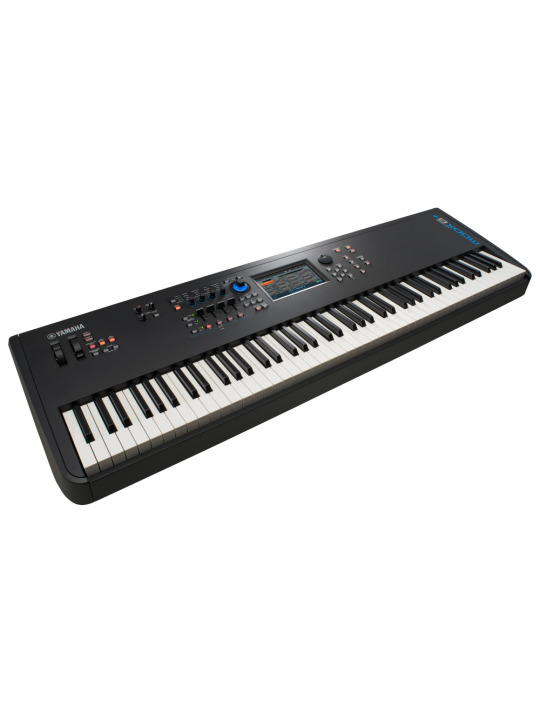
Full Concert Voice Of The Grand Piano
The MX88's Full Concert Grand piano is taken straight out of the MOTIF series. The Full Concert Grand piano's strong, focused low end, intricate midrange, and pure high end make it ideal for any musical genre and setting.
Synth Sound
Get the MX88 Montage Synthesizer instead of sacrificing sound quality for portability! With 88 notes, the MX88 is a small and lightweight music synthesizer with 88 full-sized, touch-sensitive keys and over 1,000 Voices from the legendary MOTIF.
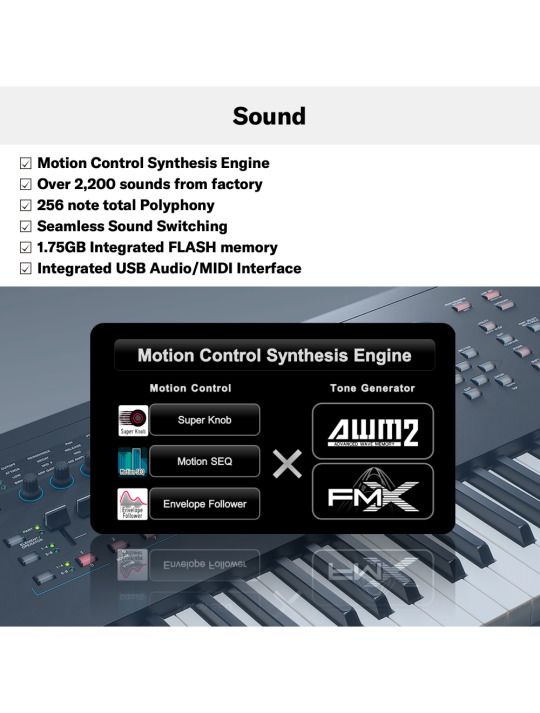
Perfect Touch Curve
An improved touch curve unites the GHS action with the Full Concert grand piano voice. The player can express themselves with great realism, dynamic, and emotion thanks to this curve. This is only achievable with a piano made by Yamaha, who has been producing concert grand pianos of the highest caliber for more than a century.
Music For Contemporary Piano Players
In addition to an acoustic piano, the MX88 has a remarkable assortment of keyboard voices. Select from vintage tonewheel organs with rotary speaker effects or faithful reproductions of vintage tine and reed electric pianos. If you want to get funky, there are also forceful and percussive Clav sounds available. This vast range of sounds makes it the Best Synthesizer Keyboard for music creation.
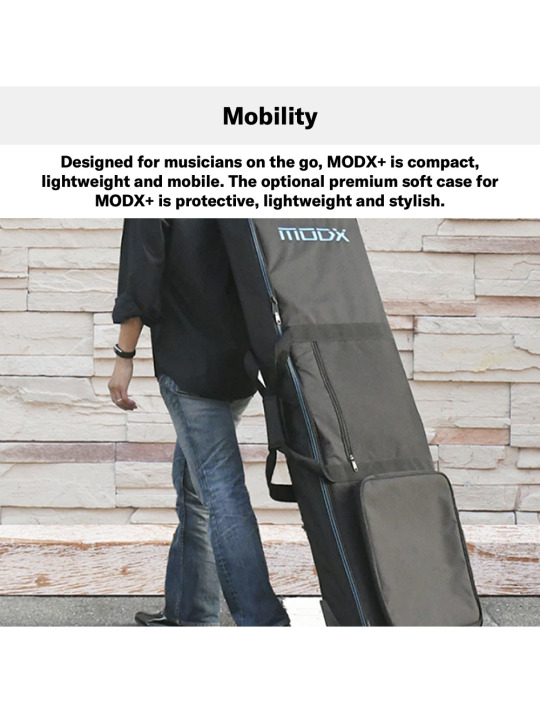
Drum Kits, Guitars, Basses, And Realistic Strings
The MX88 is an inspiring instrument for orchestrators, instructors, and producers due to its amazing reproductions of orchestral strings, woodwinds, pipe organs, brass, and more. The extremely expressive and playable percussion kits, basses, tonewheel organs, and acoustic and electric guitars provide the budding producer with a potent and polished sound palette.
Motif Sound Engine
One potent Synthesizer Keyboard technology for creating sound is the MOTIF Sound Engine. Up to eight Elements can be found in MOTIF Sound Engine Voices. These components can be zoned so that a separate element plays in different regions of the keyboard or layered for a rich, full sound. Additionally, you can randomize Elements for anything from subtle variation to experimental sound, or you can swap between Elements based on velocity for extreme dynamics.
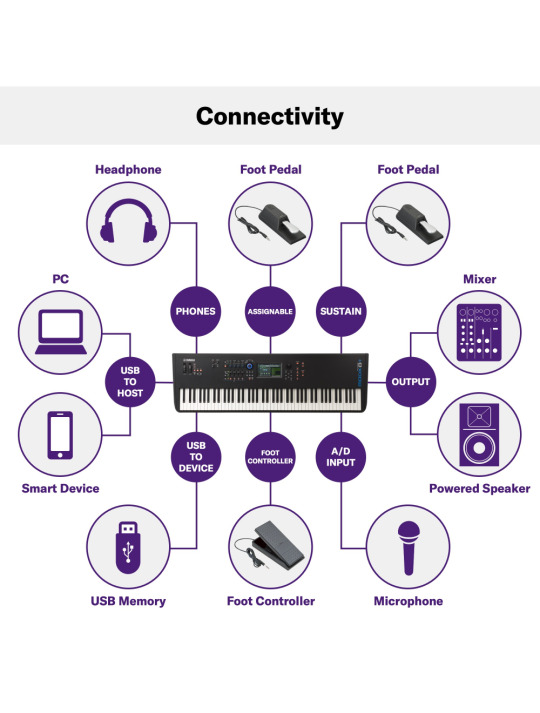
An iOS 4-Operator FM synthesizer app called FM ESSENTIAL is available for free. A complete 271 FM Voices, ranging from iconic '80s to cutting-edge modern EDM, may be unlocked by connecting the MX88 Music Synthesizer (via the Apple Lightning to USB Camera Adapter, not included) to the regular version, which only has 10 Voices. Additional features for editing voice are unlocked which makes it a great synth at a great Synthesizer Price. In-built effects, EQ, drum phrases, and a step sequencer for automating control changes are all elements of FM Essential
Effect of virtual circuit modeling (VCM)
Virtual Circuitry Modeling models the circuits down to the original analog component level, recreating the sound and behavior of vintage effects and high-end studio signal processors.
128-Note Polyphony
With 128 notes of polyphony, you can perform live or with entire 16-track sequences without experiencing any dropouts. Software synthesizers for Mac and PC, DAW software, and iOS applications can all be used with the MX88.
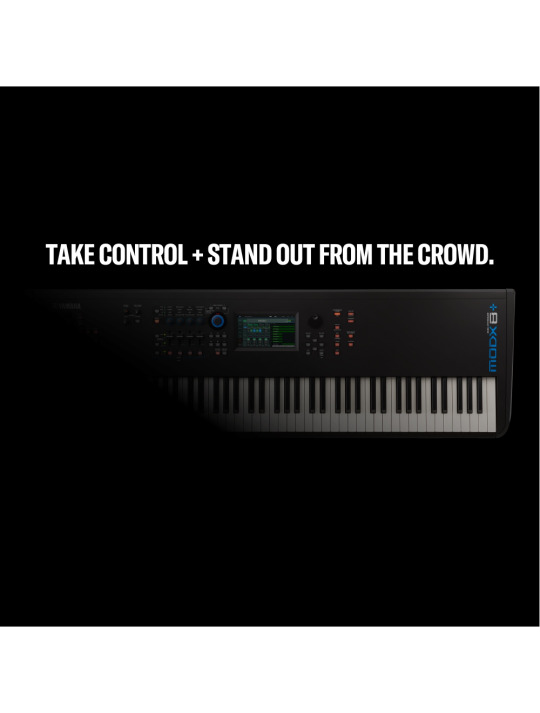
Connectivity
The MX88 allows you to record and playback stereo audio to and from your computer or iOS device because it complies with USB audio and MIDI classes. When using headphones or speakers to listen to your mixes after recording the MX88 into your DAW, this is ideal.
In addition to connecting to your DAW, the synthesizer keyboard doubles as a dedicated control surface. Utilize your DAW's onboard transport controls to adjust plug-in parameters using the control knobs. Numerous pre-installed Remote Control Templates are available to interface with well-known softsynths and plug-ins, enhancing the hardware-like feel of your software. Additionally, a 16-channel MIDI interface with DAW remote control capability is available for using the MX88 as both a keyboard controller and tone generator.
The MX88 is more than a great-sounding synthesizer; it's the hub of your studio! Get the Best Synthesizer Online from the Yamaha online store.
#Best Synthesizer Keyboard#Best Synthesizer Online#Montage Synthesizer#Synthesizer Keyboard#Synthesizer Price#Yamaha Synthesizer
0 notes
Text
Supercharge Your Sound with BEEF: The Ultimate Sonic Enhancer

If you're a music producer or sound engineer, you know the struggle of getting your tracks to sound thick, punchy, and full of flavor. That's where BEEF by Anarchy Audioworx comes in. This nifty little plugin is like a secret weapon for your audio arsenal, instantly adding weight, depth, punch, and clarity to any sound.
What is BEEF?
BEEF isn't your typical distortion plugin. It's a multi-effect processor that combines a clever blend of dynamic processing, wave shaping, tube emulation, saturation, distortion, bit crushing, and filters to give your sounds a rich, analog character. Think of it as throwing your audio on a virtual BBQ and cranking up the heat to get that perfect sizzling sound.
youtube
Why You Need BEEF in Your Toolbox
Make your instruments stand out in the mix: Whether you're thickening up a thin guitar sound or adding some grit to your drums, BEEF can help your instruments cut through the mix and grab the listener's attention.
Add warmth and character: Want to infuse your tracks with some analog warmth? BEEF's tube emulation and saturation will give your audio that smooth, vintage vibe.
Get creative with distortion: From subtle saturation to full-on sonic mayhem, BEEF's distortion options let you unleash your inner mad scientist and experiment with different textures.
Easy to use, even for beginners: With its simple one-knob interface and a variety of presets to get you started, BEEF is perfect for producers of all levels.
But wait, there's more!
Right now, you can snag BEEF for a limited-time discount of 76% off, bringing the price down from $64 to a super-tempting $14.99. That's an absolute steal for a plugin that can have such a dramatic impact on your sound.
Here's what you get with BEEF:
Simple and intuitive interface with one knob to control the amount of processing
Resizable window to fit any screen size and resolution
A variety of presets to help you get started and inspire you
Super low CPU usage for smooth and stable performance
Works with any DAW that supports VST or AU plugins
Compatible with any sound source, from synths and drums to vocals and guitars
Don't miss out on this chance to supercharge your sound with BEEF! This limited-time offer won't last forever, so grab it while it's hot.
Click here to get BEEF for only $14.99!
P.S. Don't forget to subscribe to our Blog for more music production tips and tricks!
0 notes
Photo
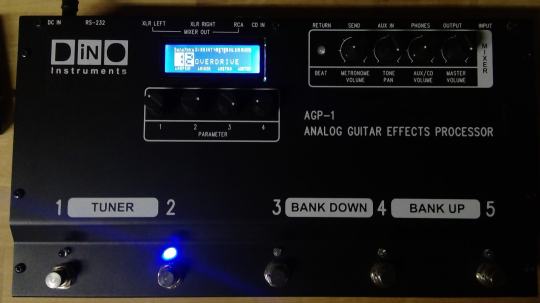
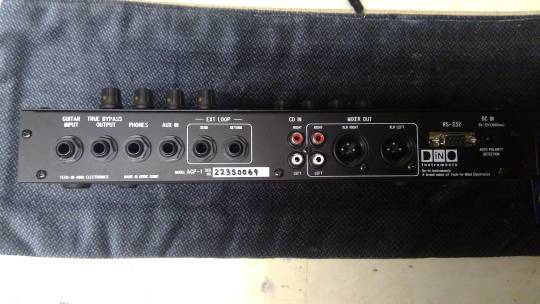

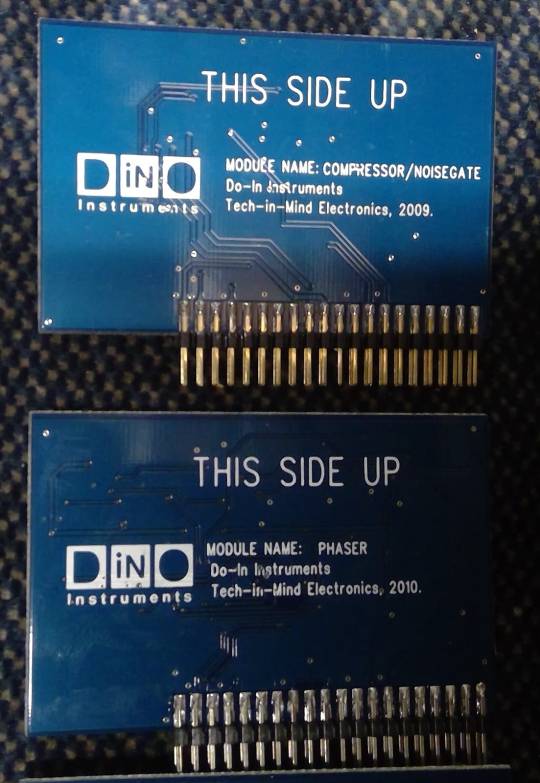
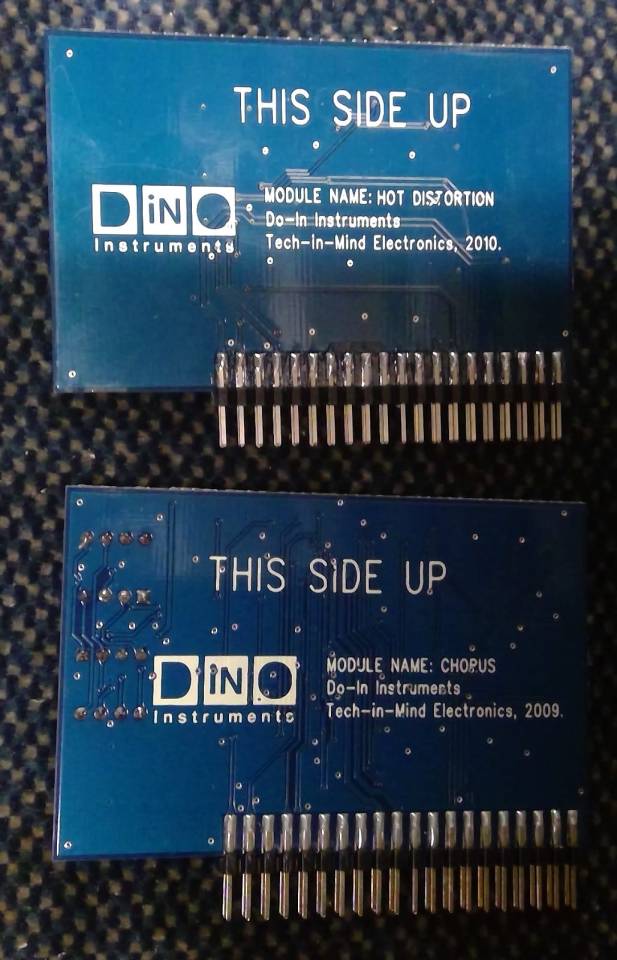
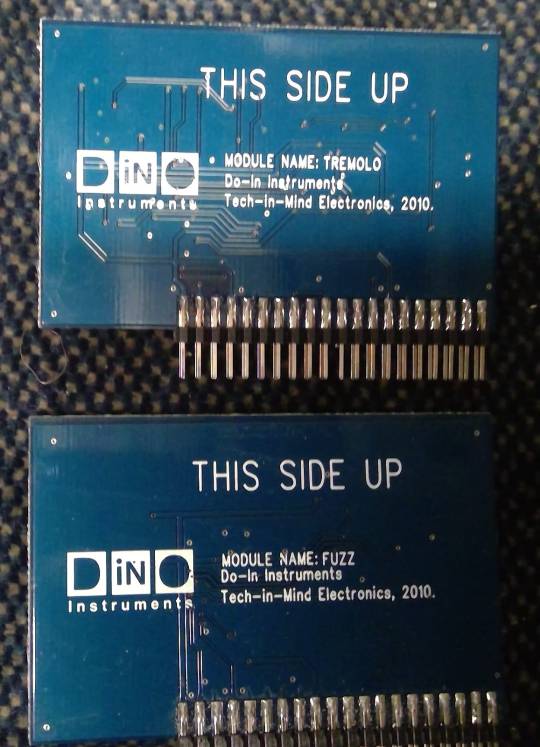

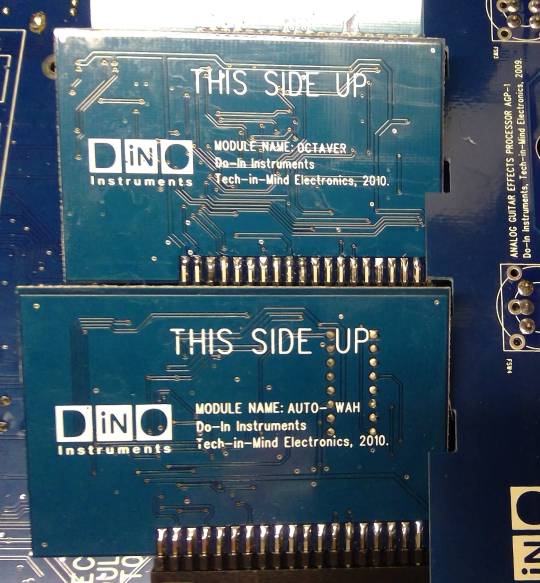
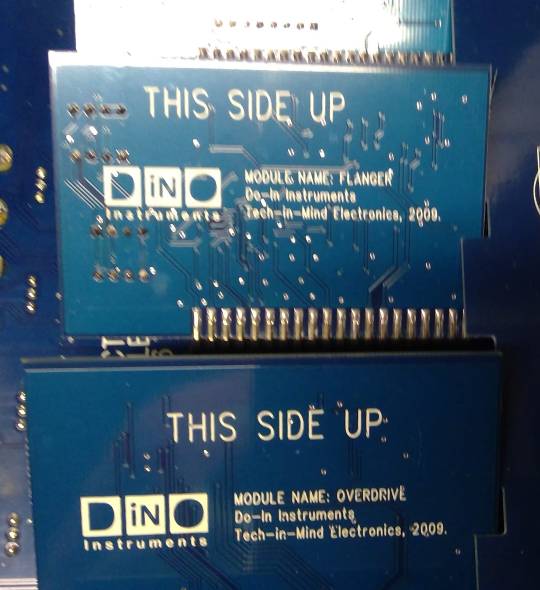

Tech-in Mind Electronics - Do-In Instruments - AGP-1 Analog Guitar Effects Processor, 2009
"This strange gem is an all analog signal path multi-Fx with 13 all analog effect modules plus 2 internal effects with digital control of all parameters. ... This was the brainchild of a Hong Kong startup called Tech-in-Mind Electronics in 2009. The unit is called the AGP-1 (analog guitar processor 1). The effect modules (my guesses as to what the circuit mimics): Compressor/Noisegate (sounds like a Ross or MXR) Phaser (sounds like a Phase 90) Hot Distortion (Rat maybe) Chorus (analog chorus, not a chorus connoisseur, so no clue what it is like) Tremolo (solid state trem) Fuzz (don’t know what flavor, but it is fuzzy) Acoustic Simulator (sucks as an acoustic simulator, fun as a sound maker) Metal Distortion (thicker and more high harmonics than Hot Distortion) Octaver (tracks and sounds like a Boss octaver pedal) Auto-wah (70’s flavored envelop filter sound) Flanger (analog flanger, smooth and nice) Overdrive (sounds like a Tube Screamer to me) Delay/Echo/Reverb (The delay is gorgeous! It is as tasty as any analog delay that I have had (Memory Man and DOD). Not a reverb at all, but it is a legit bucket brigade analog delay. Enough delay time to get dotted 8th and quarter note delays depending on tempo. No idea what the millisecond time is.)
It also has two internal effects: 7-Band EQ (reasonably flexible) Amp Sim (I compared this to a Tech 21 SansAmp classic and it sounded identical to a specific setting that was clean and warm)
Additional features: Mixer with several inputs (see photos) Metronome Tuner (not the greatest, but works in a pinch. Headstock tuners put it to shame.)
The AGP-1 came along at the height of the DIY pedal building movement, and I would guess that many of the circuits that were popular among builders at the time were used for the modules. The 10 modules can be moved around into different order in the 10 internal slots. It is a fussy business moving them around as each module has something like 30 pins on them that need to line up with the sockets in the main device. ... Oh, and it has an RS-232 jack intended for firmware updates. It was rather dated in 2009. It is comical now! The company is long gone, so no firmware updates."
s. demo clip
A retro 80s version of the Devi Ever console?
s. more variable ciruit pedals
cred: reverb.com/Tim’s Gear Garage
18 notes
·
View notes
Text
Ableton Live 10 Crack Keygen Mac Windows Free Download Version 2020 /2021
Download Here : https://bit.ly/2C6iETG
Ableton Live 10 Crack 2020 is one of the best digital audio workstations with all musical instruments and features for producing unusual and attractive soundtracks and for live performances. Furthermore, it has the latest tools and functions for editing, organizing, recording, mixing, as well as making audio tracks. It is the most recommended software for experts and professional DJs because of its sophisticated toolset. It has a complete collection of useful effects containing beat matching, crossfading, turntables, and many more like these. You can easily match the beats with the help of this software.
Ableton Live Activation Code has a beautiful and elegant interface design, which is not much complex and offers the best performance for music track production and live performances. It also contains a single user interface which simple and easy to use. It is free from pop-ups or notifications. You can customize it in your way, like hiding certain parts of the interface as well. It contains two views one is the arrangement, and the other is the session. In the session view, you have different tools for triggering clips.
These clips set using MIDI control and audio. At the same time, you can organize all of these sequences the way you want them quickly. Besides, the user can add as many effects to these clips as he wants to create unusual sounds. It also can play a set of clips together. Also, Ableton Live Crack has a layout that you can use to record all tracks and edit all tracks as you like. It also has features to delete the MIDI controller manually. It also has many useful features for classical composers.
Download Here : https://bit.ly/2C6iETG
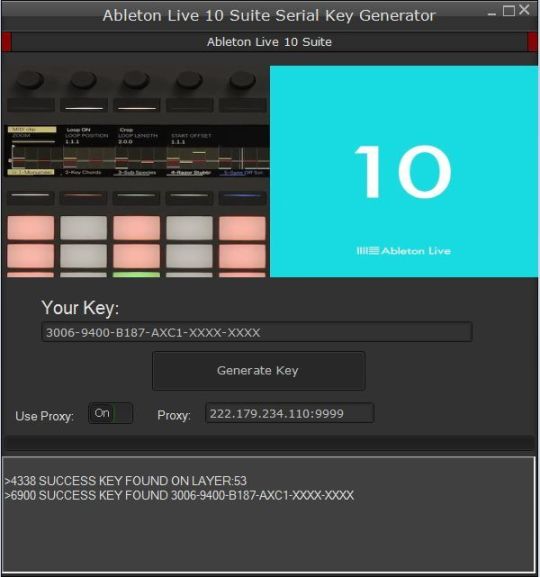
1) Ableton Live is available for macOS and Windows: We think this is an excellent reason to work in Ableton and not use FL Studio, which design for macOS only for Windows or Logic. If you have a Macbook and a Windows PC with portable audio screens, you can share project files between two workstations and continue production. Top Music Arts can bring together music producers to make Ableton Tutorials and Ableton Templates available on both platforms.
2) The Fastest: We have tested many sequences: Reason, Cubase, FL Studio, etc. We found this to be the fastest sequential. This processor pretty much saved, especially if you have an older computer with a slow processor. It includes full effects automation, track freeze function, easy-to-use audio samples, VST / AU support, and other technical things we’ll talk about in the next post.
3) File manager: Ableton Live does a great job of managing files. It’s effortless to find what you’re looking for, type the following: For the plugin, if you need pro q to light, go to VST folder manager and call pro-q. Just drag it to the app, and you have done. You have a new feature where you can put and color your favorite plugin. Ableton has this browser that doesn’t take up much space.
4) Usability: Ableton Live is easy to use. In layout, you can put any MIDI channel or audio channel sample and drop the / vst tool and mixer/effect plugin. Here is an example of Ableton Piano, Ableton Reverb, Ableton EQ, and Ableton Compressor. Is Ableton Live Crack Free?
You can download Ableton Live for free from our website CrackKnow.com. The premium software is present to try for free on the platform. The Ableton live free is available for macOS and Windows OS.
Key Features of Ableton Live 10.1.14 Crack:
New Synthesizer: Wavetable
Ableton Live 10 is a powerful synthetic synthesis compact. Similar to Xphar and uses the curve of its oscillators. Its part of the unit contains two projectiles and two LFOs, which can compare to any parameter in the synthesis. Other features include forming tables, subsections, and two filters.
New audio effects
Drum bus
The most common effects of drum sets are compressors, chains, and temporary designers. Roller drum combines effects and makes rounding easier. It also allows you to dial bass at a specific frequency with additional controls for the added character.
Echo
It is a new delay effect that combines classic analog sound with modern digital audio. It has many features, including noise, adjustment, saturation, and even rules of conduct.
Pedal
This effect gives you the sound of driving, distortion, and physical guitar pedals. It may be useful for heating the music, adding the device to the guitar section, or adding harmonics to tune the bass.
Download Here : https://bit.ly/2C6iETG
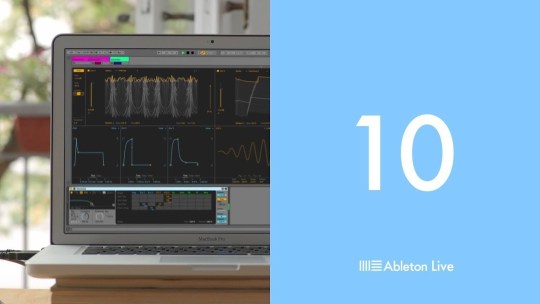
1 note
·
View note
Photo

$725.0 Only! ~ Valley People Dynamite Stereo Compressor Limiter Gate - Vintage Analog Processor, Rack Guitar Effects, Guitar Multi Effects, Best Guitar Multi Effects, Guitar Multi Effects Processor, Multi Effects Pedal Electric Guitar BUY HERE! #RackGuitarEffects, #GuitarMultiEffects, #BestGuitarMultiEffects, #GuitarMultiEffectsProcessor, #MultiEffectsPedalElectricGuitar,
0 notes
Text
How to Choose an Recording Microphone,Audio Mixer for Live Sound, and others
The most fundamental function of the audio mixer—or mixing console, as it is sometimes referred to—is to combine audio signals, process them, and then direct them to their destination. Nowadays, a lot of different devices can mix and match. With the right apps and interfaces, even tablets and smartphones can perform some mixing functions. Additionally, every DAW (Digital Audio Workstation) software comes equipped with mixing features. However, a dedicated hardware mixer's real knobs, faders, and buttons remain indispensable for many home studio owners and performers. Continue reading to determine whether an audio mixer is the best option for your situation. Table of Contents Essential Mixer Terminology Analog vs. Digital vs. Software Mixers Powered Mixers Live Sound Packages DJ Mixers Line and Summing Mixers Things to Look for When Shopping for a Mixer Summing Up In this buyer's guide, we will discuss three primary categories of audio mixers: Mixers for recording, also known as studio mixers Mixers for live sound, also known as PA mixers or sound system mixers Mixers for DJs Because many mixers support both live sound and recording functions, it is not always easy to tell the difference between the two. There are numerous audio mixers available today that can meet your needs for recording and on stage. The basics of mixer terminology As you shop for a mixer, you might come across unfamiliar terms. We have provided the following glossary to assist you in understanding the specifications and features that you will be reading about. The basic structure of a channel is a signal path. More things can be connected to and routed through a mixer with a lot of channels. Most of the time, microphones and/or line-level devices like amplifiers, preamps, or signal processors can be incorporated into channels. Electronic signals are produced at a much lower level by instruments like guitars and basses and microphones than by line-level devices.) A channel strip is a collection of circuits and controls that work together on a particular mixer channel to affect the audio signals that pass through it. Common examples include: a jack for an external instrument, microphone, or other device affixed to the mixer. To reduce interference and noise, XLR inputs are balanced. Other inputs accept quarter-inch TRS connectors or RCA connectors. a microphone preamp that raises the relatively weak mic signal to line-level strength equalization, also known as EQ, adjusts the signal's frequency response dynamics processing, which may include compression or gating (described below) routing, which directs the signal to other mixer circuitry and external devices a fader, which slides along a track to control the input or output of a channel, and a meter, which visually displays the output of each channel I/O How you intend to use the mixer will determine how many inputs and outputs you require. For example, if you're mixing live sound, you'll need a mixer with enough inputs to handle microphones and other connected devices, as well as outputs to connect your main and monitor speakers. The mixer may need to supply power to drive the main and monitor speakers, depending on the speakers being used. In contrast, when it comes to mixing recordings, you'll want to think about how many instruments and performers you'll need to record simultaneously. Other devices that will be a part of the signal chain and recording process should be included in the I/O calculation for studio mixers. These would include signal and effects processors, headphones, monitor speakers, microphone preamps, and instruments that use DI (direct injection) boxes to connect directly to the mixer. Buses Buses are represented as intersections in circuits where the outputs of multiple channels meet. The signals from each mixer channel are sent to a particular bus or group of buses. The main mixer output is sent to speakers or a recorder via the master mix bus, which is fed by the channel faders. Auxiliary buses, also known as aux sends or aux buses, can send signals through their own output jacks and are fed by the volume controls of the channels to which they are connected. Post-fader sends are the name given to these things. Pre-fader sends, which operate independently of the channel's volume, are another type of aux bus. Sending a specific mix of signals to headphones, effects processors, or monitor speakers makes use of these outputs. Groups Mixers with multiple channels typically have a group function that lets you control and process multiple channels simultaneously. Because it shares the same signal processing and routing as a sub-mixer, a group is like a sub-mixer in that it controls all channels with a single fader, making it easier to control the output to the master bus. A drum kit's mics, for instance, can all be assigned to a single group, making volume and sound control of the drums simple. A mute function is also present in some mixers that allow for channel grouping. When you want to silence a group of inputs or open mics, such as when making announcements on stage, this is useful. A "scene" feature, available on some more advanced mixers, lets you store various group configurations of muted and unmuted channels. Inserts A channel insert connects specific channels to external sound processors like compressors and equalizers, typically after the channel's preamp stage. There may be a patch bay that lets multiple external devices connect to larger mixers. Direct Output These enable the mixer's preamplifier output to be fed to recording systems and external audio interfaces. Cue System The cue system enables you to listen in on particular channels without affecting the mixer's output. The signal is typically routed to monitor speakers or a headphone amplifier. Most of the time, cue systems let you listen to the signal before or after the fader has changed it. You can hear the original signal without sending it to a signal mix with pre-fader listening, or PFL. The ability to isolate the signal that is affected by the fader with after-fader listening (AFL) is useful for signal troubleshooting. A useful feature for sound checks is the Solo In Place (SIP) function on some larger mixers, which silences all channels except the one being sampled. Mixers: Analog, Digital, or Software? Analog mixers have been around for nearly as long as PA systems and audio recordings. Digital mixers began entering the professional audio market in the 1990s. Both their affordability and capabilities have improved since then. Software-based mixing became a reality in the early years of the 21st century as related hardware and computers became more powerful. We will briefly examine the capabilities, advantages, and disadvantages of each type. Analog Mixers Despite digital mixers' greater adaptability, analog mixers continue to be popular due to their generally lower cost and user-friendliness. They can be easier to use than digital soundboards because their functions are controlled by physical knobs, faders, and switches. The analog mixers' tendency to have a larger footprint due to their use of physical controls is a drawback in crowded home studios and cramped stages. Since everything is visible on the analog mixer's hardware and signal routing rather than hidden in the menus of a digital soundboard's numerous status screens, many people find it easier to understand at a glance. High-quality sound can be transmitted by both analog and digital mixers. The digital mixer's analog to digital converter (ADC) and the quality and design of its electronic circuits, particularly the mic preamps, have the greatest impact on sound quality. The majority of sound engineers concur that the greatest obstacles to absolute sound fidelity are microphones and speakers, which by their very nature exhibit a greater degree of coloration and distortion. However, for good sound, mic preamps that boost the output of the microphone without introducing coloration or distortion are essential. The hiss that is inevitable with analog mixers can be reduced by using high-quality circuitry and components in the gain stages and signal routing of the mixer. Digital Mixers Digital mixers are hard to beat when it comes to instant changes to signal routing, flexible and extensive signal dynamics, and an incredible variety of effects possibilities. On an analog audio mixer, even a skilled octopus would be unable to achieve preprogrammed routing and effects with just a single button press! Software plug-ins that enhance tone shaping capabilities are compatible with some digital boards. They also have the ability to herd on the dreaded feedback, stopping howls and squeals before they begin. Automatic gating, which silences channels with little or no signal passing through them, is another nice feature. The ability to save and recall mixes is one of the most significant benefits of digital mixers. Settings from previous performances are frequently saved on internal memory or USB flash drives by many. This makes it simple to set up in a saved location. During sound checks, recalling mixes from similar venues can save a lot of time even in a new venue. You can pre-program mixes on a laptop computer with some digital mixers, so you only need to tweak the sound when you get to the gig. Motorized faders that respond to saved configurations are present in some advanced digital mixers. Due to their adaptability, digital mixers may have some drawbacks. Their tremendous adaptability comes at a cost: Mastering all of your mixer's options may require a steep learning curve. However, as with any complex digital device, it is typically not necessary to learn every function; however, being able to save settings and tailor the interface to your requirements can assist you in navigating its complexity. How quickly you can learn the essential features will depend a lot on how well the user interface is designed. You can find mixers with a lower learning curve by talking to other mixer users, participating in pro audio forums, reading reviews, and viewing demos and tutorials. Software Mixers You can start mixing without having to worry about space or money like you would with traditional analog and digital mixers if you have a laptop that is set up right, some mixing software, and a small control surface. Software for music production can do almost everything you can with a physical mixer in terms of signal processing and routing. You can now perform basic audio mixing with your iOS or Android smartphone or tablet thanks to simple audio mixing apps. Software mixers, which are used for recording, make it simple to incorporate virtual instruments, samples, drum loops, and a lot more into your productions. Using a computer-based digital audio workstation (DAW) opens up a vast world of possibilities, including the use of a MIDI controller keyboard to create and record music. The majority of mixer applications support advanced MIDI functions. When first starting out with software mixing, the learning curve can be steep, just like it is with physical digital mixers. The same advice applies: Talk to other musicians who use mixing applications, read reviews written by experts, and peruse the numerous customer reviews on fs-elec.com. Powered Mixers A powered mixer eliminates the need to transport and set up separate power amplifiers to drive your main and monitor speakers if you're looking for a mixer to handle your live performances. There are many different sizes and configurations of powered audio mixers. They are able to handle anything from a solo acoustic singer-guitarist with just one or two mics, an acoustic-electric guitar, and small speakers to a full band with a lot of mics, electric instruments, big main and monitor speakers, and so on. In terms of options for routing, effects processing, EQing, and many other features, powered mixers offer the majority of the features found on unpowered mixers. Like with any mixer, you'll need to figure out how many inputs and outputs you need and how much power is needed to drive your stage monitors and PA speaker cabinets. Ease of use is a crucial factor to take into account because the majority of solo acts and bands that perform in smaller venues are responsible for their own sound engineering. In recent times, portable integrated PA systems with speakers, mixer, and power amplifier all in one unit have entered the market. Live Sound Package When looking for a mixer to handle your live shows, a live sound package is something to think about. The majority, if not all, of the audio gear you'll need to perform live is included in these bundles of live sound equipment. Speaker stands, powered mixers, main and monitor speakers, and all necessary cables are typically included in packages. Mice are also included in some. These bundles usually cost a lot less than buying the individual parts because they are carefully matched for compatibility. DJ Mixers Due to their numerous turntables and/or CD players, DJs require specialized mixing techniques in order to maintain a seamless flow of music. DJ mixers have the right inputs to handle DJ gear and integrate with PAs and club sound systems to meet these requirements. There is a wide range of capabilities among DJ mixers. Low-cost, simple units may only have two or three inputs and outputs. They also come with basic EQ and volume controls as well as crossfader functions that let you mix the output of a few turntables or CD players. Kill switches for instant control over particular frequencies, hamster switches that reverse crossfader channel operation, and metering that displays clipping (distortion) and output levels are all added features to DJ mixers that are more advanced. The DJ is able to easily communicate with the audience thanks to talkover switches and mic inputs. The most advanced DJ mixers integrate with DJ software applications that enhance the mixer's capabilities and permit connection of laptop computers. Beat slicing and dicing, advanced EQ controls, and even video and light control are all features of high-end DJ mixers. The crossfaders on a DJ mixer get a lot of use, so it's important to think about how easily they can be replaced. Choosing the right DJ mixer is like choosing any other type of mixer: you need to think about the I/O you need, the features that are important to your show, and your budget. Mixers for Line and Summing Line-level signals are the focus of line-level mixers, as the name suggests. They typically only have one volume control per channel and are almost always analog in design. They are also fairly straightforward. When used live, they can be connected to multiple players to free up channels on your main mixer and provide music between sets. Summing mixers are used in studios to consolidate and tweak final mixes by adding warmth to what some engineers call the "cold" output of final digital mixes. Summing mixers are typically analog in design. To bring back the warmth of analog recording technologies, some high-end summing mixers are outfitted with tube technology. Things to Look for in a Mixer If you've looked through fs-elec.com huge selection of mixing equipment, you know there are many options. In addition to the obvious question of your budget, here is a list of things to keep in mind as you select the mixers that are most suitable for your needs. Application: Will you use your mixer to record or perform live? The ability to connect external processors and the quality of the mic preamp are crucial if you intend to use it only for recording. Make sure the mixer is compatible with your existing sound system and provides sufficient connectivity and sound processing to handle your entire band when using it for live sound. For more information on this, see I/O and Channels below.) Rugged mixers are also important because they won't stand up to the rigors of the road for long. Channels and inputs: Think about how many microphones you'll need to connect. By itself, a miked drum kit can use up to five inputs.) Mic inputs that provide phantom power for condenser microphones are necessary if you intend to use them. Additionally, you'll need enough stereo channels to accommodate stereo keyboards and other instruments in your band. Direct inputs are also required if you intend to connect guitars or basses directly to the mixer. By acquiring more channels and I/O than you currently require, it is always best to allow headroom. Over time, bands frequently expand in terms of both players and equipment. Routes for buses and signals: When it comes to recording, these functions may be more crucial. You'll need more flexibility in your routing and signal paths if you use a lot of special-purpose mixes like feeds for recording gear, monitors, headphones, and external effects mixes. Capabilities in EQ How complex are your EQ requirements? To sweeten your mix, studio recording typically necessitates finer sound adjustments. It's possible that you'll need multiband parametric equalizers to get the sound quality you want. On the other hand, all that is required for simpler live-sound mixing is straightforward control over the low, mid, and high frequencies. Other Sound Processors and Effects: Do you get the sound you want before the mixer by using external mic preamps, effects pedals, and other tone-tuning equipment? If this is the case, internal sound processors and mixer effects are less important. When playing live, on the other hand, a mixer with built-in effects and sound processing makes for a very portable setup. Summary: By this point, you should have a pretty good idea of the essential features to look for in a mixer. Now that you know more, you can find a portable live sound mixer or recording mixing console that meets your needs and your budget. Read the full article
0 notes
Text
What is Music Technology?
For those of you who are not familiar with the terminology, music technology refers to the devices used to create and play music. It includes instruments such as drums, synthesizers, samplers and sequencing machines. There are many different types of devices available, but some of the more popular and most widely used include those made by Moog.
Synthesizers
Synthesizers are devices used to create electronic sounds, enabling musicians to compose music. They can also be used to create soundscapes and music for live performances. Some synthesizers are analog, while others are digital. A synthesizer is used to control volume, intensity, and frequency of a sound.
In addition, a music synthesizer can alter the wave forms of an instrument, producing a distinctive timbre and pitch. Mixing component sounds can also give an instrument a unique sound.
The first synthesizers were experimental special-built devices. They were built in the early twentieth century by Raymond Scott, Don Buchla, and Hugh Le Caine. These devices were often configured using modularity.
Samplers
Samplers are an important tool in the music industry. They help artists insert themselves into the narrative. A sample can be any type of recorded audio. Some examples include film dialogue, streetcar noise, rain hitting pavement, or even a snippet of a song that was previously played. Using a sample allows musicians to save time and money by recording only what they need, and it also allows them to create their own beats.
Sampling has been around for a long time. Hip-Hop was the first genre to take advantage of this technology. Initially, samplers were expensive and difficult to use. However, as technology advanced, they became easier to use and cheaper to maintain.
Drum machines
A drum machine is an electronic device used to create percussion sounds. They typically have multiple modes, including a song mode, clave, waltz, and tempo adjustments. Most drum machines have built-in effects and can generate patterns in real time.
One of the first programmable devices was the Roland TR-808, which became popular in hip hop music. Its features included a high-end sequencer, and the ability to create your own rhythms.
Another innovative programmable device was the Rhythmicon, developed by Russian inventor Leon Theremin. This was the first programmable drum machine, incorporating multiple wavelengths into beats.
The Eko ComputeRhythm, meanwhile, was the first programmable drum machine with touchscreen controls. The LM-1 Drum Computer, developed by Linn, was also a milestone in the world of digital samples.
Sequencers
Sequencers are rhythmic tools used to program and create melodies, articulations, and effects. They're usually found in a hardware or software form. These may include a piano roll, step sequencer, or even a sequencer that's built into a DAW.
In the early days of music technology, sequencers were often played by hand. However, today, many are programmed. This frees up the hands of the performer to play and manipulate the sound. Using a sequencer can also save time. By programming notes in advance, a performer can play back a musical performance in a different order.
A sequencer's output is huge. Often, it's a "warmed-up" version of the output of a synthesizer. This allows for the production of interesting polyrhythms.
Side chaining
Side chaining is an audio processing effect that involves routing the output from one track to control the level of another. Typically, this is done by using a dynamics processor such as a compressor or an expander. It is a common technique that can be used to enhance the performance of a number of different instruments. The process allows you to keep the lead guitar at the forefront of your mix while minimizing unwanted ambient noises.
While side chaining can be a very powerful tool, it is also a very delicate procedure. It can lead to a muddy mix if not done correctly.
Moog Modular systems
The Moog Modular is a tabletop synthesizer created in 1968 by Wendy Carlos. It's used by artists like Stevie Wonder and Brian Eno.
These synthesizers are very popular as collectors' items. Even small ones can sell for huge sums of money. If you are interested in owning one, you can buy them on the second hand market. But you need to be prepared to do some work.
Unlike modern digital synthesizers, Moog modular systems aren't as easy to use. You need to write down the settings and connections on each module. And they lack safety features and software interfaces. They're also expensive to purchase.
0 notes